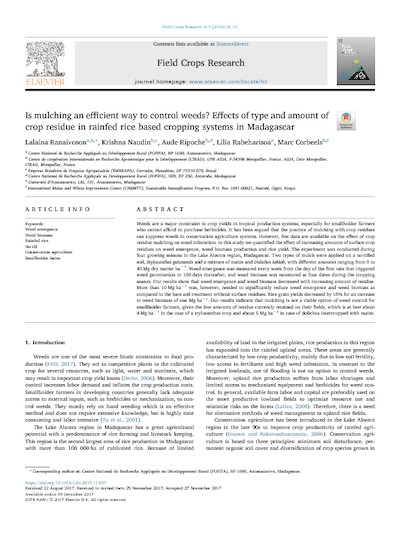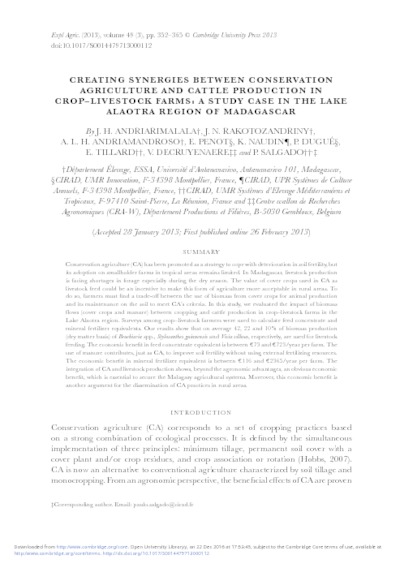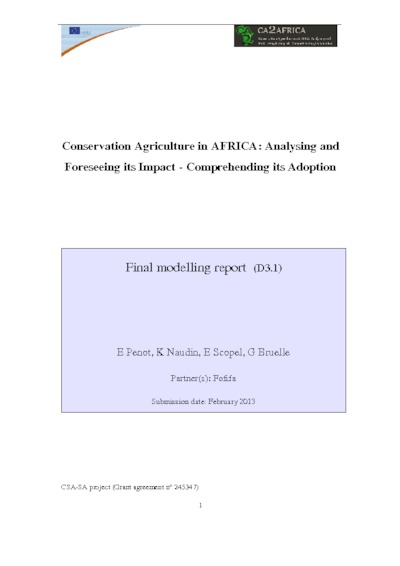Weeds are a major constraint to crop yields in tropical production systems, especially for smallholder farmers who cannot afford to purchase herbicides. It has been argued that the practice of mulching with crop residues can suppress weeds in conservation agriculture systems. However, few data are available on the effect of crop residue mulching on weed infestation. In this study we quantified the effect of increasing amounts of surface crop residues on weed emergence, weed biomass production and rice yield. The experiment was conducted during four growing seasons in the Lake Alaotra region, Madagascar. Two types of mulch were applied on a no-tilled soil, Stylosanthes guianensis and a mixture of maize and Dolichos lablab, with different amounts ranging from 0 to 45 Mg dry matter ha−1 . Weed emergence was measured every week from the day of the first rain that triggered weed germination to 100 days thereafter, and weed biomass was monitored at four dates during the cropping season. Our results show that weed e
Is mulching an efficient way to control weeds? Effects of type and amount of crop residue in rainfed rice based cropping systems in Madagascar
Trade-offs around the use of biomass for livestock feed and soil cover in dairy farms in the Alaotra lake region of Madagascar
Trade-offs around the use of biomass for livestock feed and soil cover in dairy farms in the Alaotra lake region of Madagascar
You can’t eat your mulch and have it too - Cropping system design and trade-offs around biomass use for Conservation Agriculture in Cameroon and Madagascar
Conservation agriculture is defined by three main principles: minimum soil disturbance, permanent soil cover and crop rotations. CA is promoted as a promising technology for Africa, but to date, only a small area under CA fully complies with the above three principles. CA has both short and long term effects on crop productivity and sustainability through the modification of various agroecological functions. These functions are related to the quantity of crop and cover crop biomass produced and kept as mulch. One of the main challenges in designing CA for smallholder farming systems in developing countries is the competing uses for biomass, in particular for feeding livestock. The main difficulties are linking the efficiency of agroecological functions to varying degrees of biomass export, and evaluating the performance of cropping systems at farm level, which is where the decisions are made. In North Cameroon the quantity of biomass produced in the field has been doubled by associating a cover crop with a cereal crop. Part of the biomass was consumed by cattle during the dry season but the quantity of mulch that remained on the ground had a positive impact on the cotton water balance in the driest part of North Cameroon. In the Lake Alaotra region of Madagascar, the soil cover in rice fields under CA can vary, from 30% to 84% even in the same type of field depending on the plant used as cover crop, the quantity of biomass produced and management of the residues. The range is even greater when different kinds of fields are taken into consideration. Of course, the different agroecological functions can be fulfilled to a greater or lesser extent depending on the amount of available biomass and the resulting soil cover. The relationship between the quantity of biomass and soil cover has been calculated for different kinds of residues. We used these relationships to explore the variability of soil cover that could be generated in farmers’ fields, and to estimate how much of the biomass could be removed to feed livestock while leaving sufficient soil cover. Our results showed that under farmers’ conditions in Madagascar, the production and conservation of biomass was not always sufficient to fulfill all the agroecological functions of mulch. For example, partial export of biomass to be used as forage might have no effect in terms of erosion control but may considerably reduce the efficiency of physical weed control. As the balance between the potential benefits of exporting biomass and the efficiency of agroecological functions varies depending on the constraints and goals of each farm, we chose to analyze the potential benefits of exporting aboveground biomass to feed cattle at farm level. To this end, we modeled different size farms in Madagascar to investigate the relation between raising dairy cows and efficient application of CA. Our aim was to explore trade-offs and synergies between combinations of CA practices (i.e. different amounts of biomass exported) and the size of dairy cow herds (varying biomass needs and animal production). Changing the percentage of soil cover in CA plots did not significantly modify total farm net income, as this was more influenced by the characteristics of the milk market. Overall, CA systems can be beneficial for dairy cow farmers thanks to the forage produced, although the milk market and thus the value of biomass for forage, has a major influence on the way CA can be implemented at field level. To explore the range of possible cropping systems in a given biophysical situation, we created a tool named PRACT (Prototyping rotation and association with cover crop and no till). We used this tool to organize expert knowledge on crops and cover crops, biophysical characteristics of fields and agronomic rules and to link them using Malagasy conditions. PRACT generate a list of cropping systems, i.e. crops and cover crops and their sequences over three years. These cropping systems are characterized by their potential agroecological functions and crop production. The cropping systems are first selected based on the biophysical requirements of plants, plant compatibility and agronomic rules. But all the systems are not suitable for every kind of farm. Consequently using PRACT outputs, a second selection of cropping systems can be made based on the characteristics of the cropping system, i.e. crop production and agroecological functions. In this way, the selected cropping systems can be reduced to a number that can reasonably be handled by technicians and farmers. Finally, we recommend a more rigorous definition and characterization of treatments when comparing CA to conventional systems to obtain a clearer view of the link between the impact of CA, crop rotations and the level of biomass production.
CREATING SYNERGIES BETWEEN CONSERVATION AGRICULTURE AND CATTLE PRODUCTION IN CROP–LIVESTOCK FARMS: A STUDY CASE IN THE LAKE ALAOTRA REGION OF MADAGASCAR
Conservation agriculture (CA) has been promoted as a strategy to cope with deterioration in soil fertility, but its adoption on smallholder farms in tropical areas remains limited. In Madagascar, livestock production is facing shortages in forage especially during the dry season. The value of cover crops used in CA as livestock feed could be an incentive to make this form of agriculture more acceptable in rural areas. To do so, farmers must find a trade-off between the use of biomass from cover crops for animal production and its maintenance on the soil to meet CA’s criteria. In this study, we evaluated the impact of biomass flows (cover crops and manure) between cropping and cattle production in crop–livestock farms in the Lake Alaotra region. Surveys among crop–livestock farmers were used to calculate feed concentrate and mineral fertilizer equivalents. Our results show that on average 42, 22 and 10% of biomass production (dry matter basis) of Brachiaria spp., Stylosanthes guianensis and Vicia villosa, respectively, are used for livestock feeding. The economic benefit in feed concentrate equivalent is between €73 and €723/year per farm. The use of manure contributes, just as CA, to improve soil fertility without using external fertilizing resources. The economic benefit in mineral fertilizer equivalent is between €116 and €2365/year per farm. The integration of CA and livestock production shows, beyond the agronomic advantages, an obvious economic benefit, which is essential to secure the Malagasy agricultural systems. Moreover, this economic benefit is another argument for the dissemination of CA practices in rural areas.
CONSERVATION AGRICULTURE IN AFRICA: Analysing and Foreseeing its Impact-Comprehending its Adoption
The Alaotra Lake is a wide region. Thus, there are a lot of different types of farm depending on the location, the production activities, the size and many different situations ... That explains why the dissemination and adoption of CA systems and ICS (Innovative Cropping Systems) hasn’t reached the same level in all the different zones. But, in general, Alaotra farmers are not reluctant to CA adoption at the conditions that quality extension is available for technical support and monitoring for several years (3 to 5). It is just easier and faster when the proposed systems fit with the farmers’ expectations. Here, the first challenge is to find a variety of systems that respond to the variety of situations to increase the assimilation process; but the actual important challenge is to integrate these systems sustainably into the farm production systems. Indeed, with the current restrictive national context (no agricultural politics, no incentive measures), it is crucial to create “perennial” production systems trough perennial process of innovation which is probably the most important challenge in the next future.CA does not extend spontaneously with surroundings farmers. It might be too early to effectively measure or record any trend in dissemination. However, a heart of knowledge, know-how and CA practices has been created with around 1000 farmers on 600/700 hectares of CA since 10 year. The Vakinankaratra highland area suffers from major technical constraints linked with major socio-economic lead to a situation where CA does not provide a solution acceptable for local farmers. Three main factors are not in favor of C A with current systems : i) competition for biomass between CA cropping systems (mulch) and livestock feeding requirement, 2) Coldness of the dry season with unadapted cover or associated crops leading to insufficient mulch and iii) delay in growth of crops in CA systemsThe do observe a new situation an a new trend since 10 years with the recent boom on upland rice on tanety, opening a new field or research to suggest solutions for soil fertility maintenance with rice based cropping systems.
CREATING SYNERGIES BETWEEN CONSERVATION AGRICULTURE AND CATTLE PRODUCTION IN CROP–LIVESTOCK FARMS: A STUDY CASE IN THE LAKE ALAOTRA REGION OF MADAGASCAR
Conservation agriculture (CA) has been promoted as a strategy to cope with deterioration in soil fertility, but its adoption on smallholder farms in tropical areas remains limited. In Madagascar, livestock production is facing shortages in forage especially during the dry season. The value of cover crops used in CA as livestock feed could be an incentive to make this form of agriculture more acceptable in rural areas. To do so, farmers must find a trade-off between the use of biomass from cover crops for animal production and its maintenance on the soil to meet CA’s criteria. In this study, we evaluated the impact of biomass flows (cover crops and manure) between cropping and cattle production in crop–livestock farms in the Lake Alaotra region. Surveys among crop–livestock farmers were used to calculate feed concentrate and mineral fertilizer equivalents. Our results show that on average 42, 22 and 10% of biomass production (dry matter basis) of Brachiaria spp., Stylosanthes guianensis and Vicia villosa, respectively, are used for livestock feeding. The economic benefit in feed concentrate equivalent is between €73 and €723/year per farm. The use of manure contributes, just as CA, to improve soil fertility without using external fertilizing resources. The economic benefit in mineral fertilizer equivalent is between €116 and €2365/year per farm. The integration of CA and livestock production shows, beyond the agronomic advantages, an obvious economic benefit, which is essential to secure the Malagasy agricultural systems. Moreover, this economic benefit is another argument for the dissemination of CA practices in rural areas.
Conservation Agriculture in AFRICA: Analysing and Foreseeing its Impact - Comprehending its Adoption
Executive summary 2 sites have been selected for the study: the lake Aoatra area, considered as CA successful and Vakinakratra/Highlands considered as CA failure. Modeling at plot and cropping systems level The comparison of soil loss results obtained by direct and indirect estimations showed that generally soil loss calculated from direct measures were lower than those obtained by RUSLE. Therefore, to improve and calibrate RUSLE model at Lake Alaotra, a correction factor was proposed, mainly the reduction of the P factor by making the amount of soil loss by simulation closer to the direct measurement on field. So, extrapolation or modeling of soil loss depending on the soil management mode appeared valid for rice and maize crops, by using for CA systems different types of mulch the most used in the region at Lake Alaotra such as mulch of rice, maize+dolichos and stylosanthes. The DSSAT experiment was realized on two experimental fields that had been installed by the URP SCRiD at Andranomanelatra. From these studies, it was impossible to use the cropping model to assess the weight of water factor in the variability of inter-annual yield in these regions. It was demonstrated that in the Vakinankaratra, the part of yield variability due to stress water in conditions of study was not important, but at Lake Alaotra, it is responsible for a significant inter-annual variability of yields. The study also highlighted the big differences between achievable yields to the yields observed in field, even under controlled conditions, demonstrating the impact of other limiting factors for both regions. These studies allowed us in isolating the weight of climate and water factor on the variability of rainfed rice yields. Thus, it appears that plant health problems including weeds are similarly responsible of some differences between observed and achievable yields and the difference between treatments in the test, but there is probably also an important problem of nutrition mineral crops, contributing strongly to the differences between observed and achievable yields, and to the differences between treatments. The models tested can be used for the prediction of the potential and achievable yields with the available water in the soil conditions and the climates in which they were calibrated. Some potential advantages of CA for cropping rainfed rice (improvement of water balance, and control on water erosion) have been efficiently tested with the models f But for taking into account other potential effects of CA (weeds control, P availability, improvement of Soil organic matter stocks…) the crop models need still to be improved.
GT3 : « Impacts socioéconomiques des SCV et déterminants de la diffusion de l’innovation »
Depuis 2007, l’AFD, le FFEM et le MAE ont financé le Programme d'Appui Multi Pays en Agro-écologie (PAMPA), pour une durée de cinq ans. Ce programme a pour objectif de réaliser une évaluation de l'impact des systèmes de semis direct sous couverture végétale (SCV), en combinant des recherches sur différentes échelles complémentaires à travers le monde. Dans le cadre de ce programme, un projet intitulé RIME (Réponse Intégrée Multi- Equipes) a officiellement démarré en 2009. Le projet RIME est composé de quatre Groupes de Travail : (GT1) Evaluation du stockage de carbone par les sols sous SCV ; (GT2) Etude des impacts écologiques des SCV à l’échelle paysage ; (GT3) Evaluation des impacts socioéconomiques des SCV et déterminants de la diffusion de l’innovation ; (GT4) Evaluation du capital sol et élaboration de politiques de conservation. Les activités du GT3 concernent trois terrains avec une forte implication actuelle et passée de services de développement pour appuyer la diffusion des SCV (Madagascar, Cameroun et Laos) et deux terrains où des activités de mise au point de références techniques, ont été réalisées, cherchant à évaluer quels types de SCV peuvent être développés et leur impact biophysique (Brésil et Vietnam). Le présent document concerne la synthèse des résultats issus des activités mises en place à Madagascar par le GT31. A Madagascar l’approche est centrée sur l’exploitation agricole pour étudier l’impact de l’insertion des SCV dans les systèmes de production i.e. étudier l’impact des SCV sur les flux de trésorerie, les temps de travaux, les assolements, les relations entre les systèmes de culture et les systèmes d’élevage, etc.
Effet des plantes de service sur les bio-agresseurs des cultures
Etude bibliographique sur les plantes utilisées dans les systèmes de culture sur couverture végétale (SCV) à Madagascar
Candidate plants to help soil pest control in conservation agriculture.
Candidate plants to help soil pest control in conservation agriculture. Potential effects of 21 species used as cover crops in Madagascar










